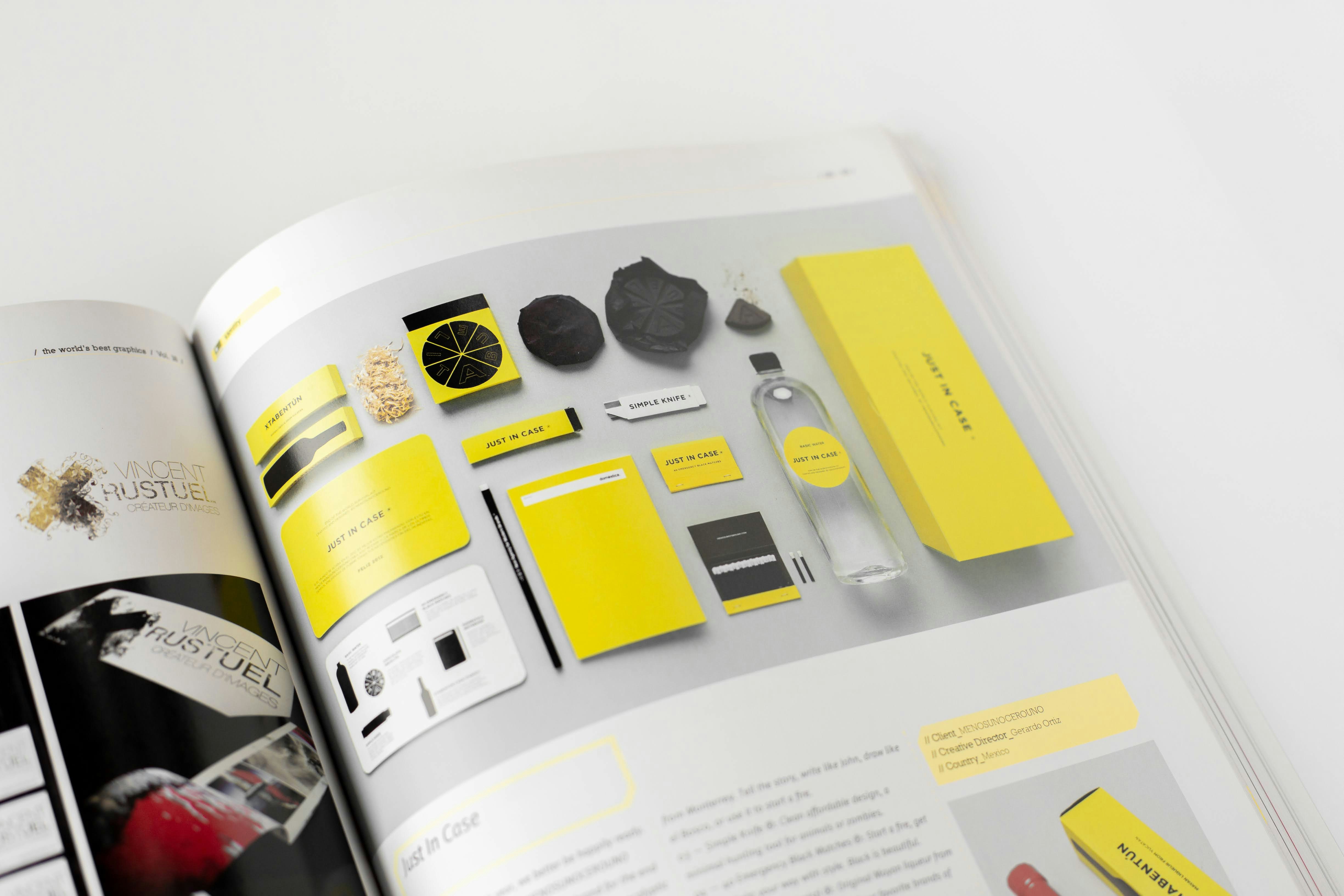What is Brand Identity and Why Does Your Business Need It?


In the business world, first impressions are crucial. For small businesses, which often compete with larger and more well-known companies, creating a striking and memorable image becomes not just desirable but a necessary condition for survival and growth. This is where brand identity comes in—a visual system that helps a business stand out from competitors, earn customer trust, and build a strong emotional connection with its target audience.
Brand identity (or visual identity) is a set of visual, verbal, and other elements that create a cohesive and recognizable image of a company in the eyes of consumers. It’s a kind of visual language that a brand uses to communicate with its audience, express its values, and differentiate itself from competitors.
In this article, we’ll take a closer look at what brand identity is, what elements it consists of, how it helps small businesses grow and thrive, and how modern technologies, including AI, make professional identity design accessible even to small companies with limited budgets.
What is Brand Identity and Why is it Important for Small Businesses?
Brand identity is a combination of consistent visual and verbal elements that create a unified, recognizable image of a company and its products in the perception of consumers. Sometimes, brand identity is referred to as corporate or visual identity.
The Difference Between Brand Identity and a Brand
Before diving into the details, it’s important to understand the difference between brand identity and a brand. A brand is a broader concept that includes not only visual elements but also the company’s reputation, customer perception, values, and brand promises. Brand identity is the visual part of the brand, a tool through which a company communicates its values and distinguishes itself from competitors.
Why Brand Identity is Especially Important for Small Businesses
For small businesses, having a professional brand identity is even more crucial than for larger companies, and here’s why. First, it creates the first impression. Small businesses often only get one chance to capture the attention of a potential customer. A professional brand identity signals seriousness and the quality of the company’s products or services. Second, it creates a sense of stability and reliability. Consistent use of brand elements across all customer touchpoints gives the impression of a stable, trustworthy company. Third, it enhances brand recognition. With a limited marketing budget, it’s especially important that every interaction with a potential customer works towards building brand recognition. Additionally, brand identity sets a business apart from competitors—a unique and memorable brand identity helps small businesses stand out even against larger, better-funded competitors. Lastly, it saves resources—once developed, a brand identity with clear usage guidelines ensures consistency across all marketing materials without additional design costs.
Key Elements of Brand Identity for Small Businesses
Brand identity consists of many elements, but for small businesses, it’s especially important to focus on the key components that will form the foundation of a recognizable brand image.
Logo
A logo is the central element of a brand identity, acting as the visual symbol of a company and its values. For small businesses, it’s important to create a logo that reflects the essence of the business and its positioning, is easy to remember and recognize at a glance, scales well—looking good on both a business card and a storefront sign, works in monochrome—important for economical printing, and stands out among competitors without copying their ideas.
There are several types of logos, and each one may suit small businesses depending on their characteristics. A wordmark logo, for example, is a logo consisting solely of the company’s name in a unique font (e.g., Google, Coca-Cola).
Source: www.jessicajonesdesign.com
Icon — a graphic element without text (e.g., the Instagram logo).
Source: www.graphicsprings.com
Combination logo — a combination of an icon and text (e.g., Adidas).
Source: www.graphicsprings.com
Emblem — text inside an icon or shape (e.g., Starbucks).
Source: www.sg-educate.com
Lettermark — an abbreviation of the company’s name (e.g., IBM, HBO).
Source: www.jessicajonesdesign.com
You can read more about how a logo influences brand perception in this article.
Color Palette: How Colors Influence Perception
Colors have a strong psychological impact and can evoke specific emotions and associations. A well-chosen color palette conveys the brand’s character—dynamic or calm, premium or accessible; it triggers the right associations with the industry or product; helps the brand stand out from competitors; and improves memorability—people tend to remember colors better than names.
For small businesses, it's recommended to choose 2-3 primary colors and 2-3 secondary ones, which will be used in varying proportions depending on the context.
In color psychology in business, blue is often associated with reliability, professionalism, and trust (frequently used by financial companies); green represents growth, ecology, health, and freshness; red evokes energy, passion, urgency, and attention; yellow suggests optimism, youth, and accessibility; black conveys premium quality, elegance, and authority; and white stands for purity, simplicity, and modernity.
When creating a logo, consider what emotions you want to evoke in your audience. Familiarize yourself with color psychology and choose the color scheme that resonates most clearly with your brand’s values and target audience.
You can generate a color palette in just a few clicks using the color palette generator by Ironov.
Typography: Choosing Fonts
Fonts, like colors, convey the character of a brand and influence the perception of information. To create a consistent brand style, small businesses are advised to select 1-2 primary fonts for all materials, define rules for font usage in headings and body text, and consider readability across different sizes and mediums.
The main categories of fonts include:
- Serif fonts, which convey tradition, respectability, and academic feel.
Source: www.fabrikbrands.com - Sans-serif fonts, which symbolize modernity, cleanliness, and minimalism.
Source: www.impactplus.com - Script fonts, which express creativity, uniqueness, and a personal touch.
Source: www.jessicajonesdesign.com - Display fonts, which are distinguished by expressiveness and character.
Source: www.genlogo.com
Branding Elements: Patterns, Icons, and Graphics
Auxiliary graphic elements make the corporate identity more diverse and flexible. These include patterns — repeating designs used for packaging, website backgrounds, and advertising materials; icons — simplified images that convey concepts or actions in a unified style; photographic style — a consistent approach to selecting, processing, and composing images; illustrations — drawn elements that complement other components of the corporate identity and help convey complex ideas.
Corporate Letterhead and Business Cards
The corporate letterhead unites the logo, company name, slogan, and other permanent elements into a single composition that is used across different media. Business cards often become the first physical contact a client has with a brand, so they should reflect the core elements of the corporate identity and create the right impression of the company.
Business Documentation and Marketing Materials
A unified style should be evident across all business documents and marketing materials: letterhead and contract forms, envelopes and folders, presentations and commercial proposals, brochures and pamphlets, price lists and catalogs.
How Corporate Identity Helps Small Businesses
A professionally developed and consistently applied corporate identity provides small businesses with several significant advantages that directly affect their competitiveness and financial performance.
Building Brand Recognition
Brand recognition refers to the ability of consumers to identify a company by its visual or verbal elements. For small businesses with limited marketing budgets, high brand recognition is especially valuable. It shortens the path to purchase: a recognizable brand grabs attention faster and requires less advertising. It also creates a scale effect: even a small company can appear solid and professional. Additionally, it enhances the effect of advertising: every advertising message works not only to sell but also to build recognition.
Building Customer Trust
A professional corporate identity creates the impression that the business is stable and reliable. Consistent visual branding signals internal organization. It also reflects professionalism: high-quality design is associated with high-quality products or services. And attention to detail: a well-thought-out corporate identity shows that the company cares about the customer experience.
Research shows that 75% of consumers judge a business’s reliability by its visual presentation, which is especially important for small companies that don't yet have widespread recognition.
Differentiation from Competitors
In saturated markets, where competitors' offerings are often similar in functionality and price, corporate identity can become a key differentiating factor. It creates an emotional connection with customers that goes beyond rational benefits. It helps occupy a unique position in consumers' minds, expressing values and the brand's character, which cannot be copied like product features.
Attracting the Target Audience
A well-developed corporate identity attracts those clients who are most likely to be interested in the company's offer. It signals positioning (premium or mass-market, conservative or innovative), reflects values that may resonate with the target audience (eco-friendliness, technological innovation, family values), and creates an emotional response important for purchasing decisions.
The Internal Value of Corporate Identity
In addition to external benefits, corporate identity also has internal value for the business. It boosts employee motivation, as they take pride in being part of a brand with a strong visual identity. It fosters a sense of unity within the team. It helps maintain consistency in communication, saving time and resources.
Developing Corporate Identity for Small Businesses
Creating a successful corporate identity for a small business is not just a design project; it’s a strategic process that starts with a deep understanding of the business, its goals, and its audience.
Target Audience and Competitor Analysis
Before starting the design process, it’s essential to conduct research that will serve as the foundation for all subsequent decisions. Audience analysis should include demographic characteristics: age, gender, income, education, profession; psychographic characteristics: values, interests, lifestyle, habits; and behavioral traits: how decisions are made, where information is sought, pain points, and needs: what problems your product or service solves.
When analyzing competitors, focus on their visual solutions: what colors, fonts, and styles they use; positioning: how they position themselves and what values they promote; strengths and weaknesses: what can be improved and which niches are underexploited; industry trends: which visual trends dominate your sector.
Defining Brand Values and Positioning
Based on the market analysis and internal business characteristics, you should formulate the mission and vision: why your business exists beyond profit-making; brand values: principles the company follows; unique selling proposition: what sets you apart from competitors; brand character: if your brand were a person, what would they be like.
These intangible aspects will form the foundation for creating a visual identity that is not only attractive but also strategically sound.
Creating a Logo and Other Corporate Identity Elements
The design process typically involves the following steps: Concept development begins with brainstorming and idea generation that reflects the essence of the brand, creating mood boards — collages that convey mood and style, and sketching various design directions.
Next, the logo design phase begins: working on several logo options, testing the logo on different media and at different sizes, refining the chosen option into a final version.
Then comes the development of other elements: selecting the color palette and defining usage rules, choosing and adjusting the font pair, creating additional graphic elements, and developing templates for key corporate identity carriers.
The final step is creating a brand book or guideline: documenting all corporate identity elements, describing usage rules, and creating examples and templates for different applications.
Budget-Friendly Options for Developing Corporate Identity
For small businesses with limited budgets, there are several options for creating professional corporate identity. Freelancers: individual designers often offer services at lower prices than agencies. Online services: platforms for creating logos and basic corporate identity elements. Design contests: websites where you can announce a contest and choose the best option from those submitted. Neural networks and AI tools: new technologies that make design creation accessible even without specialized skills.
Using Neural Networks for Corporate Identity Creation
In recent years, neural networks have revolutionized the design world, providing small businesses with access to professional design solutions without the need to hire expensive specialists or agencies.
Overview of Neural Networks in Design
Modern neural networks and AI tools offer a wide range of possibilities for creating corporate identity elements. They can generate logos based on business descriptions, keywords, and preferences, create color palettes that harmonize with each other, select font pairs that match the brand's character, generate patterns and background images in a unified style, create icons and illustrations that align with the brand's visual language, and develop layouts for different corporate identity carriers.
How Neural Networks Help Generate Ideas and Create Designs
Neural networks analyze millions of design examples and, based on this, can propose visual solutions that correspond to current design trends, consider industry specifics, and brand positioning, and offer diverse options to choose from, quickly adapting to changing requirements.
The process of working with a neural network to create a corporate identity typically involves describing the business and its features, defining the target audience and desired style, choosing industry examples for inspiration, generating several logo options and other elements, and refining the selected option based on feedback.
Ironov — a neural network for creating corporate identity, through which you can easily create a logo and other elements and see how the final result will look on real objects.
Source: Ironov
Advantages of Using Neural Networks for Small Business
The use of AI technologies in creating corporate identity offers several significant advantages for small businesses, such as budget savings: the cost of creating corporate identity through neural networks is many times lower than with design agencies; speed of development: initial designs can be generated in minutes rather than weeks; flexibility and iteration: it's easy to make changes and generate new variations; accessibility for non-professionals: no specialized design knowledge is required; variety of options: the ability to quickly explore different design directions.
Adapting Corporate Identity for Different Communication Channels
Businesses interact with customers through multiple channels — website, social media, apps, messages, etc., and the corporate identity should work effectively on each of them.
Website and Digital Platforms
A website and other digital touchpoints often serve as the first introduction of a client to a brand, so it is important to adapt the logo for different screen sizes and formats, create a responsive design that looks good on all devices, consider how information is perceived in the digital environment, and maintain a consistent style across the website, email newsletters, and online ads.
Source: Ironov
Social Media and Messengers
Social media platforms have their own features and requirements for visual content, so it is important to take into account the formats and sizes specific to each platform (square posts for Instagram, horizontal posts for Twitter); adapt the color palette to suit the perception of each social network; create templates for regular posts while maintaining the corporate identity; and develop unique elements for each platform, ensuring brand recognition is preserved.
Source: Ironov
Printed Materials: From Business Cards to Packaging
Despite digitalization, printed materials remain an important element of brand communication. These include business cards — often the first physical contact with the brand; brochures and catalogs — detailed presentations of products and services; corporate letterheads — contributing to the formation of a professional image; packaging and labels — continuing the brand's communication with consumers; promotional products — spreading the brand through useful items.
When adapting for print, it is important to consider factors such as color reproduction in print (CMYK instead of RGB); ensuring bleed areas and safe zones for proper printing; checking font readability at different sizes; and accounting for the properties of materials and how they impact the perception of color.
Source: Ironov
Ensuring a Unified Style Across All Touchpoints
A key principle of a successful brand identity is consistency across all channels. To ensure style unity, it is recommended to develop clear brand guidelines that can be used by any employee or contractor; create templates for all typical materials to simplify the creation of new ones; regularly audit all customer touchpoints and assess their alignment with the brand identity; train employees on the rules for using the brand style; and use modern tools for collaborative content creation, ensuring adherence to standards.
Source: Ironov
Evaluating the Effectiveness of Brand Identity
Like any business investment, a brand identity should deliver measurable and assessable results.
Key Evaluation Methods
- Surveys and Questionnaires — The most common way to measure brand recognition. Respondents are asked about their familiarity with the brand, its attributes, and associations.
- Spontaneous Recall Testing — A method in which participants are asked to name brands in a certain category without prompts.
- Prompted Recall Testing — Respondents are shown a list of brands and asked to identify those they’ve heard of.
- Search Query Analysis — Studying the frequency of brand-related search queries using tools like Google Trends.
- Social Media Metrics — Tracking brand mentions, hashtags, and audience engagement across social media platforms.
Key Metrics
- Share of Voice — The ratio of brand mentions to the total mentions in the category.
- Audience Reach — The percentage of the target audience familiar with the brand.
- Loyalty Level — The willingness of consumers to choose the brand again.
- Net Promoter Score (NPS) — Measuring how likely consumers are to recommend the brand to others.
Regular evaluation of brand recognition allows companies to track the effectiveness of marketing campaigns, adjust their strategies, and strengthen their market position. To obtain the most accurate results, it is recommended to combine multiple evaluation methods.
Examples of Successful Brand Identities for Small Businesses:
A well-executed brand identity helps small businesses stand out in the market and be remembered by consumers. Here are a few notable examples of companies that have managed to create a memorable and effective brand identity despite limited resources:
Surf Coffee
Surf Coffee is a coffee shop chain with a unique conceptual style based on surfing culture. The brand’s style focuses on informality and a youthful atmosphere, helping attract young, active people.
Brand Elements:
-
Logo featuring a surfer and a wave, symbolizing freedom and an active lifestyle.
-
Color palette: muted, natural shades of blue, white, and sandy colors.
-
Stylish yet simple and functional packaging.
Surf Coffee has created a unique image that evokes a spirit of adventure and freedom, attracting a younger audience and making the coffee shops stand out from competitors.
Source: surfcoffee.ru
Simple Wine
Simple Wine is a small business focused on selling wines and educating customers about the wine culture. The company has managed to create a recognizable brand identity that reflects its expert approach and commitment to simplicity in wine selection.
Brand Elements:
-
The logo is designed in a minimalist style, emphasizing elegance and the simplicity of choice.
-
The primary color palette is white and burgundy, symbolizing wine and purity of choice.
-
The design of wine menus and packaging focuses on premium quality, while maintaining accessibility.
Simple Wine stands out with its approachable yet professional presentation, making the brand recognizable among wine enthusiasts.
Source: modaseason.ru
Dodo Pizza
Dodo Pizza is a Russian pizza chain that started as a small business but has grown into an international network. A key part of its success is the vibrant and modern brand identity, which is aimed at an active, young audience.
Brand Elements:
-
A bright orange logo in the shape of a dodo bird, which immediately attracts attention and is memorable.
-
The color palette consists of orange and black — a combination that emphasizes energy and dynamism.
-
Simple and functional design of the menu, packaging, and interiors, all oriented towards a young audience.
Dodo Pizza's brand identity has been one of the driving factors behind the company’s rapid growth. Its bold and memorable image makes it easily recognizable among competitors in the fast food sector.
Source: brandbook.dodopizza.info
Brand identity plays a crucial role in the development of small businesses, helping them stand out from competitors, create a recognizable image, and gain the trust of their target audience. A comprehensive approach to visual identity, including a logo, color palette, typography, and brand elements, contributes to the formation of a strong brand that can attract and retain customers.
Small businesses that invest in developing their brand identity gain a significant competitive advantage, as brand recognition and positive perception directly influence customer trust and their decision to choose the company. It is important to remember that adapting brand identity to different communication channels — from websites to social media — supports brand consistency and strengthens its impact.
In today’s environment, technologies, including neural networks, offer small businesses new opportunities to save time and resources when creating unique brand identities. Tools like those from Ironov allow businesses to quickly and creatively design logos and other identity elements, ensuring high levels of personalization with minimal costs.
Creating an effective brand identity is an investment that pays off through increased recognition, customer acquisition, and strengthening the brand's position in the market.


